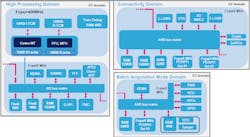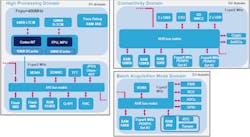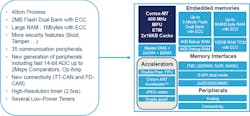High-Performance, Low-Power Cortex-M7 Microcontroller Targets Secure IoT Applications
ST Microelectronics' new STM32H7 series is built using 40-nm flash technology and runs at 400 MHz (Fcpu) to deliver high performance with low power requirements. It delivers an EEMBC CoreMark score of 2010. The ARMv7E-M microcontroller is partitioned into three sections (Fig. 1). The peripheral sections operate at 200 MHz (Fcpu/2), with some peripherals operating at 100 MHz (Fcpu/4).
The system uses only 280 µA/MHz in run mode and less than 7 µA in standby mode—8 µA when the 4 Kbyte backup RAM is included. The real-time clock (RTC) adds under 1 µA to standby mode. This is half the power used by the previous generation STM32F7. The STM32H7 batch acquisition mode (BAM) uses only 150 µA/MHz and has a wake-up time of only 70 µs. It takes 405 µs to switch from any stand-by mode to run mode. That 4-Kbyte backup RAM is also protected by tamperproof circuitry.
The chip is available with up to 2 Mbytes of flash memory with ECC (Fig. 2) implemented in a dual-bank configuration, allowing programming of one bank while executing code from the other. This is ideal for remote updates. The RAM also has ECC support. This includes 864 Kbytes of regular RAM, 192 Kbytes of tightly coupled memory (TCM), and L1 caches of 16 Kbytes for instruction and data. There is a 4-Kbyte debug RAM that works in conjunction with the embedded trace module (ETM).
The system has a boot loader that is locked down; there will be additional service routines available, as well. The boot loader allows operation with a range of storage devices in addition to the on-chip flash memory. The chips have dual QSPI interfaces as well as two SD/SDIO/MMC interfaces. There is also a memory controller for off-chip SDRAM, NOR, and NAND storage. There is on-chip secure memory for system and user use designed for storing protected cryptographic keys. Flash memory sectors can be marked for protected execution that the memory protection unit (MPU) supports.
Connectivity varies depending upon the chip, but most include support for SPI, I2C, and serial ports. Additional options include Ethernet as well as flexible data-rate CAN (FD-CAN) and time-triggered CAN (TT-CAN) support. USB is in the mix, as well.
The chips include a number of hardware accelerators, such as the dual-precision floating point unit (DP FPU). The Chrom-ART accelerator is for improving 2D graphics performance with a TFT-LCD controllers, and there is a JPEG codec additionally included. The chips have a hardware random number generator (RNG) along with a crypto and hashing accelerator.
Analog peripherals include a 14-bit ADC that handles up to 2 Msamples/s. The ADC has differential inputs and supports a sigma-delta modulator. Chips support a mix of operational amplifiers and comparators.
The STM32H7 includes 10-year support, making it ideal for long-term applications. Software support includes ST’s own development platform that includes the STM32CubeMX configuration code generator. The family also has wide third-party support. it will be supported by ST’s Discovery Board series, as well as other development kits and reference designs.
About the Author
William G. Wong
Senior Content Director - Electronic Design and Microwaves & RF
I am Editor of Electronic Design focusing on embedded, software, and systems. As Senior Content Director, I also manage Microwaves & RF and I work with a great team of editors to provide engineers, programmers, developers and technical managers with interesting and useful articles and videos on a regular basis. Check out our free newsletters to see the latest content.
You can send press releases for new products for possible coverage on the website. I am also interested in receiving contributed articles for publishing on our website. Use our template and send to me along with a signed release form.
Check out my blog, AltEmbedded on Electronic Design, as well as his latest articles on this site that are listed below.
You can visit my social media via these links:
- AltEmbedded on Electronic Design
- Bill Wong on Facebook
- @AltEmbedded on Twitter
- Bill Wong on LinkedIn
I earned a Bachelor of Electrical Engineering at the Georgia Institute of Technology and a Masters in Computer Science from Rutgers University. I still do a bit of programming using everything from C and C++ to Rust and Ada/SPARK. I do a bit of PHP programming for Drupal websites. I have posted a few Drupal modules.
I still get a hand on software and electronic hardware. Some of this can be found on our Kit Close-Up video series. You can also see me on many of our TechXchange Talk videos. I am interested in a range of projects from robotics to artificial intelligence.




